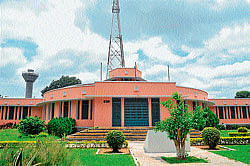
There is a great aura around the building which looks very elegant and understated and reflects the nature of the people working inside. The architecture of the building is exceedingly attractive and interestingly each studio is meant for a particular type of programme production and there is a central hexagonal studio room which could be used for several important purposes.
“This is a uniquely designed studio which you will not see any where in the country or perhaps even in the world,” said M S Vijaya Haran, station director, All India Radio, Mysore, speaking to City Herald.
There are many firsts which Akashavani boasts of. As many of us know this was the first private station (when the private FM radio stations were no where in the picture), to be started by a psychology professor Dr M V Gopalaswamy in 1935 as an amateur experimental station with a low power transmitter of about 35 watts power.
The nearly four hundred pages souvenir brought out on the occasion of the Platinum Jubilee celebrations last year, edited by Vijaya Haran, is so very beautiful, that going through it takes one down the memory lane.
In fact the first souvenir was brought out in 1950 when the transfer of Akashvani to AIR took place on April 1,1950. Some of the articles are a historian’s delight and the one by Dr A M Natesh, the then assistant director on “The Future of Broadcasting” which talks about every detail and where no topic is left untouched is very illuminating.
As we learn from the souvenir, we realise how closely University of Mysore was involved with Akashavani as many of them, like assistant directors N Kasturi, A N Moorthy Rao and all of them highly qualified, with the first director Gopalaswami himself having Ph D, teaching in the university, were instrumental in laying firm foundations for Akashvani.
There is no topic that is left untouched and the souvenir truly reflects the path Akashvani has taken in its 75 years journey. As one turns the pages, the documentation that has been done by this august institution over the years is reflected in each and every page.
In its long years of existence, Akashvani has seen many ups and downs right from the time when it was shifted from Vittal Vihar, the private rented residence of Gopalaswami to the old exhibition building and then to its present one. “This is the first station in South India to be totally digitalized. This is the only station which continuously broadcasts from 5.50 am to 11.05 pm. We have won many national awards. You know if there is one media which also acts as an STD, it is radio,” said Vijaya.
Some of the interviews which were broadcast on Akashvani and published in the souvenir gives great insights to future generations of people to understand great minds like Kuvempu, R K Narayan, R K Lakshman and S L Bhyrappa.
The write-up of Otto Koenigsberger, the architect of the building by media expert V Basavaraj is very enriching. Koenigsberger was a jew who had won the first prize when he designed the stadium in Berlin, Germany for the 1936 Olympics. It was at that time that Sir Mirza Ismail came in contact with him and brought him to Mysore.
When Hitler came to power, the design by Koenigsberger, who held an India passport till his last breath, was discarded as he was a jew.
The German architect was given the task of designing the Akashvani building though he was initially tasked with the job of constructing a Olympic size stadium in Mysore, said Basavaraj speaking to City Herald.
If one has to understand what Mysore truly is—the rich cultural, heritage city---then it is worth going through the platinum jubilee souvenir again and again.